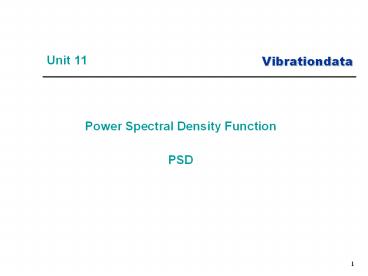Power Spectral Density Function - PowerPoint PPT Presentation
Title:
Power Spectral Density Function
Description:
Title: Unit 6e Author: The Morgans Last modified by: tirvine Created Date: 4/21/2001 9:53:41 PM Document presentation format: On-screen Show (4:3) Other titles – PowerPoint PPT presentation
Number of Views:141
Avg rating:3.0/5.0
Title: Power Spectral Density Function
1
Unit 11
- Power Spectral Density Function
- PSD
2
PSD Introduction
- A Fourier transform by itself is a poor format
for representing random vibration because the
Fourier magnitude depends on the number of
spectral lines, as shown in previous units - The power spectral density function, which can be
calculated from a Fourier transform, overcomes
this limitation - Note that the power spectral density function
represents the magnitude, but it discards the
phase angle - The magnitude is typically represented as G2/Hz
- The G is actually GRMS
3
Sample PSD Test Specification
4
Calculate Final Breakpoint G2/Hz
Number of octaves between two frequencies
Number of octaves from 350 to 2000 Hz 2.51
The level change from 350 to 2000 Hz -3 dB/oct
x 2.51 oct -7.53 dB For G2/Hz
calculations The final breakpoint is (2000
Hz, 0.007 G2/Hz)
5
Overall Level Calculation
Note that the PSD specification is in log-log
format. Divide the PSD into segments. The
equation for each segment is The starting
coordinate is (f1, y1)
6
Overall Level Calculation (cont)
The exponent n is a real number which represents
the slope. The slope between two coordinates
The area a1 under segment 1 is
7
Overall Level Calculation (cont)
There are two cases depending on the exponent n.
8
Overall Level Calculation (cont)
Finally, substitute the individual area values in
the summation formula. The overall level L is
the square-root-of-the-sum-of-the-squares.
where m is the total number of segments
9
dB Formulas
dB difference between two levels If A B are in
units of G2/Hz,
If C D are in units of G or GRMS,
10
dB Formula Examples
- Add 6 dB to a PSD
- The overall GRMS level doubles
- The G2/Hz values quadruple
- Subtract 6 dB from a PSD
- The overall GRMS level decreases by one-half
- The G2/Hz values decrease by one-fourth
11
PSD Calculation Methods
- Power spectral density functions may be
calculated via three methods - 1. Measuring the RMS value of the amplitude in
successive frequency bands, where the signal in
each band has been bandpass filtered - 2. Taking the Fourier transform of the
autocorrelation function. This is the
Wierner-Khintchine approach. - 3. Taking the limit of the Fourier transform
X(f) times its complex conjugate divided by its
period T as the period approaches infinity.
12
PSD Calculation Method 3
- The textbook double-sided power spectral density
function XPSD(f) is - The Fourier transform X(f)
- has a dimension of amplitude-time
- is double-sided
13
PSD Calculation Method 3, Alternate
- Let be the one-sided power spectral density
function. - The Fourier transform G(f)
- has a dimension of amplitude
- is one-sided
- ( must also convert from peak
to rms by dividing by ?2 )
14
Recall Sampling Formula
- The total period of the signal is
- T N?t
- where
- N is number of samples in the time function and
in the Fourier transform - T is the record length of the time function
- ?t is the time sample separation
15
More Sampling Formulas
- Consider a sine wave with a frequency such that
one period is equal to the record length. - This frequency is thus the smallest sine wave
frequency which can be resolved. This frequency
?f is the inverse of the record length. - ?f 1/T
- This frequency is also the frequency increment
for the Fourier transform. - The ?f value is fixed for Fourier transform
calculations. - A wider ?f may be used for PSD calculations,
however, by dividing the data into shorter
segments
16
Statistical Degrees of Freedom
- The ?f value is linked to the number of degrees
of freedom - The reliability of the power spectral density
data is proportional to the degrees of freedom - The greater the ?f, the greater the reliability
17
Statistical Degrees of Freedom (Continued)
- The statistical degree of freedom parameter is
defined follows - dof 2BT
- where
- dof is the number of statistical degrees of
freedom - B is the bandwidth of an ideal rectangular filter
- Note that the bandwidth B equals ?f, assuming an
ideal rectangular filter - The BT product is unity, which is equal to 2
statistical degrees of freedom from the
definition in equation
18
Trade-offs
- Again, a given time history has 2 statistical
degrees of freedom - The breakthrough is that a given time history
record can be subdivided into small records, each
yielding 2 degrees of freedom - The total degrees of freedom value is then equal
to twice the number of individual records - The penalty, however, is that the frequency
resolution widens as the record is subdivided - Narrow peaks could thus become smeared as the
resolution is widened
19
(No Transcript)
20
Summary
- Break time history into individual segment to
increase degrees-of-freedom - Apply Hanning Window to individual time segments
to prevent leakage error - But Hanning Window has trade-off of reducing
degrees-of-freedom because it removes data - Thus, overlap segments
- Nearly 90 of the degrees-of-freedom are
recovered with a 50 overlap
21
Original Sequence
Segments, Hanning Window, Non-overlapped
22
Original Sequence
Segments, Hanning Window, 50 Overlap































